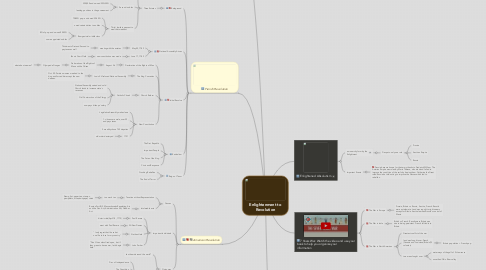
1. Age of Napoleon
1.1. Napoleon Himself
1.1.1. 1769 in Corsica
1.1.2. lieutenant of French army
1.1.3. military successes
1.1.3.1. 1792-captain
1.1.3.2. 1796- commander of the French
1.1.3.2.1. won many battes
1.2. Domestic Policies
1.2.1. The Church
1.2.1.1. peace with the Catholic chruch
1.2.2. Codification of Laws
1.2.2.1. Civil Code
1.2.2.1.1. seven law codes to gained equal
1.2.2.1.2. Step back for women and children
1.2.3. Bureaucracy
1.2.3.1. a system of government in which most of the important decisions are made by state officials rather than by elected representatives.
1.3. Napoleon's Empire
1.3.1. Steps to Empire
1.3.1.1. treaty was broken. French v.s Britain Austria, Russia, Sweden, and Prussia
1.3.1.1.1. Napoleon won
1.3.2. Spread of Ideas
1.3.2.1. spread French Rev. Ideas of equality
1.3.2.1.1. developement of liberal raditions
1.3.3. Resistance of the British
1.3.3.1. British's mighty navy
1.3.3.1.1. defeat Empire
1.3.4. Nationalism
1.3.4.1. defeat of Empire
1.3.4.1.1. conquered people untied in their hatred of the invader
1.4. Fall of Napoleon
1.4.1. Disaster in Russia
1.4.1.1. Russia refused to fight
1.4.1.1.1. French lack food and supplies
1.4.2. Final Defeat
1.4.2.1. June 18, 1815
1.4.2.1.1. Waterloo in Beligum: French v.s Britain/ Prussia
2. French Revolution
2.1. Background
2.1.1. Three Estates
2.1.1.1. First: clergy
2.1.1.1.1. 130,000 and owned 10 %
2.1.1.1.2. higher clergy: cardinals bishops, and head of monsteries
2.1.1.1.3. parish priests were often poor from the class of commoners
2.1.1.2. Second: nobles
2.1.1.2.1. 350,000 and owned 25%-30%
2.1.1.2.2. leading positions in the governement
2.1.1.3. Thrid: lowliest peasant to wealthist merchant
2.1.1.3.1. 75-80% pop. and owed 35-40%
2.1.1.3.2. owed certain duties to nobles
2.1.1.3.3. Bourgeoisie/ middle class
2.2. National Assembly Arises
2.2.1. May 05, 1789
2.2.1.1. meeting with the estates
2.2.1.1.1. Third wants First and Second to pay taxes as well
2.2.2. June 17, 1789
2.2.2.1. new constitution was made
2.2.2.1.1. Tennis Court Oath
2.3. Initial Resolve
2.3.1. Declaration of the Rights of Man
2.3.1.1. August 26
2.3.1.1.1. Declaration of the Rights of Man and the Citizen
2.3.2. The King Concedes
2.3.2.1. Louis XVI refused National Assembly
2.3.2.1.1. Oct. 05: Parisian women marched to the king and forced him accept the new decrees.
2.3.3. Church Reform
2.3.3.1. Catholic Church
2.3.3.1.1. National Assembly seized and sold Church lands to increase state's revenues
2.3.3.1.2. Civil Construction of the Clergy
2.3.3.1.3. now pays bishops' salary
2.3.4. New Constitution
2.3.4.1. Legislative Assembly makes laws
2.3.4.2. 1. citizens are male, over 25, and pays taxes
2.3.4.3. 2. wealthy chose 745 deputies
2.3.4.4. 1791
2.3.4.4.1. old order destoryed
2.4. Radicalism
2.4.1. The First Republic
2.4.2. Important People
2.4.3. The Fate of the King
2.4.4. Crisis and Response
2.5. Reign of Terror
2.5.1. Crushing Rebellion
2.5.2. The End of Terror
3. American Revolution
3.1. Causes
3.1.1. Taxation without Representation
3.1.1.1. too much tax
3.1.1.1.1. Stamp Act: paper,tea, stamps, pamphlets, dice,newspaper, cards
3.1.2. Intolerable acts
3.1.2.1. Boston Port Bill, Massachusetts Regulating Act and the Gov. Act, Administration Act, Quebec Act
3.2. Important Individuals
3.2.1. Paul Revere
3.2.1.1. historic ride(April 18, 1775)
3.2.2. William Dawes
3.2.2.1. went with Paul Revere
3.2.3. Nathan Hale
3.2.3.1. "I only regret that I have but one life to lose for my country"
3.2.4. John Parker
3.2.4.1. “Don’t fire unless fired upon, but if they mean to have a war, let it begin here.”
3.3. Outcomes
3.3.1. shot heard around the world”
3.3.2. A new Nation
3.3.2.1. Dec. of Independence
3.3.2.2. The Constition
3.3.2.3. Bill of Rights
3.3.2.4. "All of men are created equal"
4. Enlightened Absolutism
4.1. a monarchy form by the Enlightment
4.1.1. Despots: only one rule
4.1.1.1. Prussia
4.1.1.2. Austrian Empire
4.1.1.3. Russia
4.2. Important Events
4.2.1. Prussia became known for their army thanks to Frederick William. The Austrian Empire was ruled by Maria Theresa, who tried and failed to improve the condition of the serfs by freeing them. Catherine the Great ruled Russia but did noting to improve the classes which led to rebellion.
5. 7 Years War: Watch the video and use your book to help you organize your information
5.1. The War in Europe
5.1.1. Prussia, Britain v.s Russia, Austria, French. Resutls were a stalemate. Land was roguht to right owners except for Silesia. Austria learned Prussia's control of Silesia
5.2. The War in India
5.2.1. British v.s French. Results were Britain won due to being persistent. French left India to Britain.
5.3. The War in North American
5.3.1. Greatest conflict of the war
5.3.2. land was fought over: French (Canada and Louisiana) Britain(13 colonies)
5.3.2.1. Britain population > French pop.
5.3.3. two areas fought over
5.3.3.1. waterways of the gulf of St. Lawrence
5.3.3.2. unsettled Ohio River valley
6. Enlightenment in Culture
6.1. Music
6.1.1. Important Composers
6.1.1.1. 1) Johann Sebastian Bach
6.1.1.2. 2) George Frideric Handel
6.1.1.3. 3) Haydn
6.1.2. Impacts: After listening to the music in the link, answer these questions.
6.1.2.1. I heard violins and other strings, drums, and some windpipes
6.1.2.2. I kinda feel somewhat motivated to get whatever I have to do done in a short time span.
6.2. Art
6.2.1. Important Artists:
6.2.1.1. 1) Henry Fuseli
6.2.1.2. 2) William Blake
6.2.2. Important Works:
6.2.2.1. Raft of Medusa
6.2.2.1.1. I see a lot of men(I think) suffering during a storm.
6.2.2.1.2. I notice the dark clouds and the big waves so it could mean that a divine power is upset at them.
6.2.2.1.3. I think the title is describing mother nature punishing the men
6.2.2.1.4. Perhaps the artist is trying to warn some men who thinks that they are on the top to be cautious.
6.2.2.2. Liberty Leading the People
6.2.2.2.1. I see a group of men following a lady over dead bodies who holds the French flag
6.2.2.2.2. The leader is a woman and in one of her hands is the French flag while in the other is a musket
6.2.2.2.3. I think the the title is relating to the French Revolution. The lady represents freedom. Therefore, the men are fighting for freedom
6.2.2.2.4. I think the artists is trying to get more people to join the rebellion.

